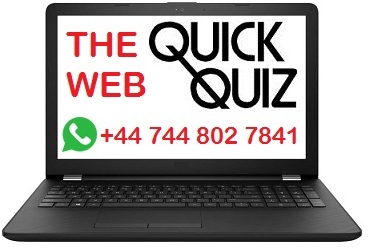Unit 4 The Web Quick Quizzes
Unit 4, Section A: Web Basics Quick Quiz
 Q1. The Internet is a global data communications network, whereas the web is a collection of HTML documents and other linked files that are accessed using HTTP.
Q1. The Internet is a global data communications network, whereas the web is a collection of HTML documents and other linked files that are accessed using HTTP.
Q2. The concept of linking documents to each other is called hypertext.
Q3. Every Web page has a unique address called a Uniform Resource Locator.
Q4. A(n) question mark symbol in a URL indicates a query.
Q5. In the URL http://www.cnn.com/showbiz, the domain name is cnn.com
Unit 4, Section B: Browsers Quick Quiz
Q1. It is important to update your browser to get patches for known security exploits.
Q2. When you use a public computer, the next person who uses it can see the Web pages you visited by looking at the history list.
Q3. If you do not want HTML and image files from recently visited Web sites to be stored on your device, delete the browser cache.
Q4. A(n) plugin, such as Adobe Reader, is a program that extends a browser’s ability to work with file formats.
Q5. A browser extension such as AdBlock or the Merriam-Webster Online Toolbar, adds features to a browser.
Unit 4, Section C: HTML Quick Quiz
Q1. A Web server sends a(n) source document to a browser, which then displays it as a Web page.
Q2. Notepad and TextEdit can be used to manually enter HTML code into a document.
Q3. <a href> is used to create hyperlinks in an HTML document.
Q4. CSS stands for Cascading Style Sheets.
Q5. Dynamic Web pages are created with scripts written in languages such as PHP and JavaScript.
Unit 4, Section D: HTTP Quick Quiz
Q1. HTTP is a(n) stateless protocol, so it cannot tell if a series of sessions were initiated by a single source or multiple sources.
Q2. A(n) third -party cookie is not set by the domain that houses the Web page displayed by the browser.
Q3. A (n) session cookie is deleted when you close your browser.
Q4. When a browser request is fulfilled, the Web server sends an HTTP status code, such as 200.
Q5. HTTP uses public key encryption, which requires two keys: one to encrypt data and the other to decrypt it.
Unit 4, Section E: Search Engines Quick Quiz
Q1. A search engine’s indexer pulls keywords from a Web page and stores them in a database.
Q2. When you enter search terms, the search engine’s query processor looks for the terms in the search engine’s database.
Q3. AND, OR, and NOT are examples of search operators.
Q4. Most search engines keep track of users by assigning a unique ID number, which is stored in a(n) cookie on the hard disk of the user’s device.
Q5. To keep track for the Web pages where you obtained information or images, you can highlight the Web page’s URL , copy it, and paste it into a list of sources. (Hint: Use the acronym.)
